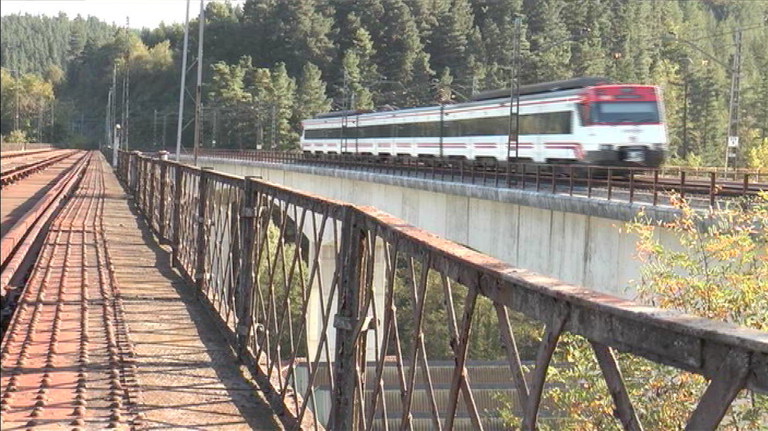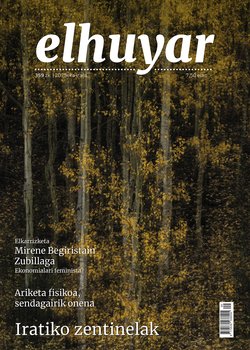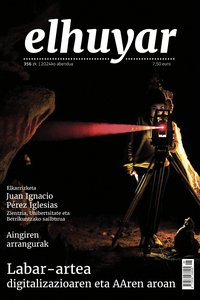In the North Railway for 150 years

The end of the 19th century. The 1,300-kilometer railway line between Madrid and Paris has been completed. The whole thing? Oh, no! No, no! The northern part of the Iberian Peninsula is still a short stretch to finish. It seems like the beginning of a comic book by Axterix and Obelix, but it is true: The towns of Beasain in Gipuzkoa and Olazti in Navarra were not yet connected by train, a route that had to be done with dilijía. This year 150 years of work on the railway between these two towns were completed. Since then it has been possible to travel from the French capital to Spain, and vice versa, without getting off the train.
IÑAKI LETURIA, Elhuyar: I don’t want to go that far. Teknopolis is on the train today. We have to make the route between Beasain and Altsasu, through the railway that ended 150 years ago. We will walk through the tunnels and bridges that were built at that time, to know the technological challenge that was for the time to carry out this immense engineering work and not only that, the North Railway also brought cultural and social changes. Passengers on the train!
This guided tour is organized by the Lemniskata association for the dissemination of science. And the truth is that knowing the history of this infrastructure is worth it. Not only because of the size or difficulty of the work, but also because of the time it took to complete it. The birds were: it took only 8 years to make the entire North Railway, 640 kilometers.
JUANJO OLAIZOLA, Director of the Railway Museum: Since then, no infrastructure of this type has been built in the entire state, neither highways nor high-speed trains... so large and in such a short time. It could be compared to the AVE between Madrid and Barcelona, but it took 12 years to make it. This in eight years and, in addition, with the elements of that time. The truth is that this work is unique.
The works of the Gipuzkoa section began in 1958, on June 22, in San Sebastián and Tolosa at the same time. In all the North Railroad, the last part to open was the Beasain-Olazti part, which indicates something. Pello Joxe Aranburu is an amateur historian and has written many books on the subject.
IÑAKI LETURIA, Elhuyar: Please tell me about the theory that Aizkorri are the Pyrenees.
PELLO JOXE ARANBURU, historian: Yes, on all planes this path appears as "El paso de los Pirineos", for them this was a tail of the Pyrenees, a continuation.
IÑAKI LETURIA, Elhuyar: Technologically it would have been difficult to overcome this.
PELLO JOXE ARANBURU, historian:One, large: height. With respect to the sea it was in Beasai, and it continues to be at 160 meters and Otzaurte again at 600 meters. in those 38 kilometers the train had to climb as straight as it could, without unevenness.
JUANJO OLAIZOLA, Director of the Railway Museum: People are surprised why the train did not take the most direct route from Beasain to Altsasu, but it must be remembered that trains do not climb the slopes very easily. The biggest advantage of the train is that its wheels are made of iron and so are the rails and then it does as skating, with little force it could move a large load, proportionally, sliding. And then to go to Beasain Altsasu you can’t go straight up like on the road, it’s a hard slope. On a normal road, it can be a slope of 6% but on the train it is almost 2% to climb the Toursuitcase.
And that's why the crossing. The valley of Urola is higher than the valleys of Oria and Deba and thus, using the orography, the train is able to climb almost 500 meters without exceeding this limit of 2%.
First stop, Orfrequencyegi. In the initial project, the plan was to move the railway along the right side of the valley, but it was decided to build a bridge because the land was unstable. 150 years later the high-speed train will leave the route that was then discarded, a sign that the technology has advanced. But even then they didn’t stop at engineering issues. This bridge was made in pieces in Paris. Then they brought it in and they set it up like a puzzle in the Orespec.
This bridge was made using the same technique that was used to make the Eiffel Tower, but 30 years ago. The technology that was used in both was riveting or roblonde, that is, the iron pieces are joined by rivets.
On the inside the bridge has more layers to increase its strength, bridges inside the bridge, so to speak; stone walls or columns of mandelery withstand compression well and steel gives flexibility to the bridge. It's all planned. Perhaps more important than what is seen is what is not seen in the case of the bridge. there are foundations of 20 meters underground, supporting the whole structure.
After being cut in the Civil War, cement columns were added.
ANE ARANBURU, Zumalakarregi Museum: They were necessary in the reconstruction process, it could not have been done otherwise, in addition to the increase in train traffic and the new columns helped to properly maintain the bridge. From there the railway bridge was already in operation, this will overturn the railway network and in 1995, for safety reasons, it will be closed after 131 years of operation and the new bridge that we will be passing today was made.
IÑAKI LETURIA, Elhuyar: Maybe not so beautiful but worth seeing the old bridge.
ANE ARANBURU, Zumalakarregi Museum: Of course I do.
After Zumarraga the landscape becomes even more mountainous. The tunnels are getting longer and longer.
JUANJO OLAIZOLA, Director of the Railway Museum: We must remember that when the train was built there was not a single tunnel in Gipuzkoa. Bridges, yes, for the passage of rivers and, although in Gipuzkoa we did not know what it was like to build a tunnel, it was only the tunnel of San Adrián, a natural tunnel. Therefore, the arrival of these French people and the execution of 14 kilometers of tunnels through Gipuzkoa, has trains of approximately 100 kilometers, so 10% of the route were tunnels.
The longest is this, also known as the Oazurza Tunnel or “Aundi Tunnel” in these areas. it has passed 3 kilometers and for 20 years it was the longest in Spain until it was made in Pajaresque. But in addition to the size, the way it was built was also amazing. They dug nine holes down the mountain, vertically, the deepest of almost 250 meters, and then began to dig the tunnel on the left right.
To do this, they used state-of-the-art technology such as that used in the construction of the Alpine tunnels: pneumatic drills or winches or cavrestants moved by perfume machines to move both people and machines up and down the tubes as in an elevator. There were also some widows inside the tunnel for the workers to eat or rest. They are covered as the tunnels are renewed. The pipes were also chimneys to evacuate the smoke from the train. And before leaving the tunnel, which gives time to say a lot to go through, it is false that the engineer who directed the work committed suicide because the two extremes did not merge
JUANJO OLAIZOLA, Director of the Railway Museum: This urban story or legend has always been told but it is not true. This tunnel was a magnificent and magnificent work and was built on time, meeting deadlines, without problems.
JOSÉ LUIS ETXEZARRETA, Lemniskata: What makes me think is that 10,000 foreign workers, including 1,000 Italians from Aosta and Piedmont, others from France, suddenly came to a valley with 17,000 inhabitants, and these were technical specialists in tunnels, etc. Let’s put it, it was a closed society at the time, an agricultural society, and suddenly 10,000 people, speaking foreign languages, in camps... let’s say it would be as seen in the films of Oeste, how the train was built, the villages organized around the train...
The expansion of this part, in addition to linking Beasain and Olazti, left many consequences. The curious thing, perhaps, was that the Italians who had been working on the railway had brought a diatonic or trikitixa sound. More fundamentally, it changed the society of Gipuzkoa from top to bottom. In Goierri, for example, before the train arrived, the largest towns were Ataun and Zegama. A few years later, Beasain and Ordizia took this place from them. More changes: the train and industrialization came hand in hand: almost at the same time, the first high ovens of Gipuzkoa were fired by Beasain 3 years before, which would later become CAF. Obviously, the train changed the story.
Buletina
Bidali zure helbide elektronikoa eta jaso asteroko buletina zure sarrera-ontzian











